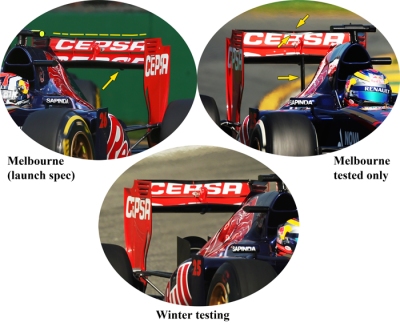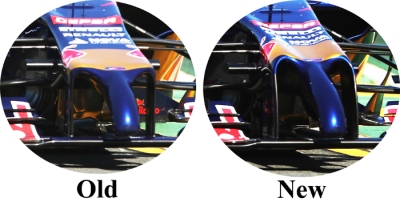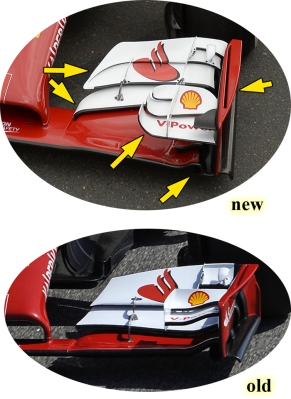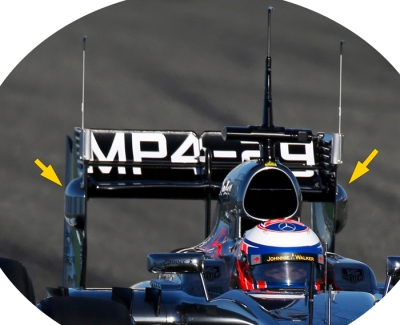Force India VJM08 – first impressions on the new car
Force India was actually the first team to launch its 2015 contender, the VJM08 on 21/01/2015. The most eye-catching points on the new car are a brand new livery and the shorter “finger” nose. However the car silhouette in general and rest characteristics feature in-depth resemblance to last season’s VJM07. Mercedes continues to power the new chassis for one more season. Without doubt Mercedes proved to be the best engine by far in 2014, not only in terms of top power but also in reliability, torque and even fuel consumption.
Starting from livery it is obvious that orange, silver and mainly black dominate on the car, while green and white are now vanished. The new colour combination brings in memory the blacked – orange Arrow cars back in 2000, with silver addition. New sponsorship logos are also visible on the chassis, advertising several new commercial partners.
Some key points on the new car are presented below 

1.Nose: New rules allowed to construct a lower nose cone with shorter and better viewing “finger” tip extension.

3:The front suspension remains push rod while the steering axis is placed between the up and lower wishbone.

4.Wheel rims: great effort and progress made over last season on the way rims fix on the car in an attempt to both reduce pit stop time and improve safety

5. twin bargeboards, the larger inner one is wavy and has a cut. Both bargeboards and sidepod panels are copied directly from late last season

Sidepods remain elegant and very sculpted at bottoms. According to team the new car has rearranged internal packaging .

6. Airbox main inlet remains triangular, there is also two additional inlets, one behind the main one and another below and behind the driver’s helmet. The whole structure is strengthened via two pylons and looks identical to 2014 VJM07

7.Floor arrangement in front of the rear wheel is alike to the one seen on VJM07 late in 2014 season
Rear suspension remains pull rod and according to the team a hydro-mechanical system replaced the original torsion springs.
Conclusion
Force India rushed to launch first its new car in an attempt to attract the lights on. Therefore, judging by what the VJM08 looks like, we jump onto two conclusions, whether it is actually a new car or an “immature” version of it. Great resemblance to VJM08 and the appearance of beam wing, an element should be absent since 2014, leaves both possibilities open. In any case the team buys precious time to further develop its 2015 contender, gaining in the same time enough exposure to its commercial partners . One thing is though certain, the car that will compete in season opening race in Melbourne will significantly differ.
Caterham CT05 – New rear mini plane at Spain
To increase the amount of downforce on the rear axle, Caterham introduced at Spain a redesigned rear mini plane (also called monkey seat) with slopping downwards extremities.
Caterham CT05 – Reduced number in rear wing pillars
Caterham modified since Melbourne the way rear wing is supported on the car. The new structure involves a single pillar, which splits into two separated elements around the terminal exhaust pipe before both meets the rear crash structure. The old design had instead two thinner pillars starting parallel below the main plane but inclined inwards when dropping down, meeting also the rear crash structure . As a side effect the mini plane above the exhaust terminal pipe had to be redesigned and remounted, adopting now a Williams alike support.
The transition to the single pillar concept may offer not necessary an aerodynamic advantage over the older design, but another more practical one. The wider single pillar provides a larger internal volume and thus being able to house the connections of DRS to the main car body, thus offering a more direct and shorter route, making it more reliable and compact.
Caterham CT05, different front wing specs between Caterham drivers duo
Kobayashi adopted since Melbourne a modified front wing, differing on cascade elements.from the previous spec. On the contrary Ericsson retained the old version for all four non European races . However in Spain, Kobayashi paradoxically reversed to the old spec while Ericsson to the new.
Different front wing set ups for a certain track, is quite common between drivers within the same team, caused mainly by how driving style suits to the car’s characteristic or when racing in mixed (dry/rainy) conditions . Cars with low front grip forces a driver, who likes understeer, to adopt a front wing that generates extra amounts of downforce and vice versa.
Sauber C33 – fully “decorated” car after Jerez test
The car tested in Jerez (pre session test) was stripped of significant aerodynamic elements like sidepod panels and nose vanes because the team focused solely on improving and checking mechanical reliability instead of pushing for the ultimate time. This changed soon after the first test as wide vertical panels attached on sidepods alongside with lateral flow conditioners and skirts added under the nose where the suspension wishbones meet the chassis.
Sauber C33 – Rear wing development from launch to Melbourne
Insufficient rear downforce production was noticeable on Sauber and thus team soon pushed to develop new rear wing designs towards downforce increase .
The initial wing version seen in Jerez had two distinctive V cuts on the trailing edge of the movable upper element where the two flap fasteners exist, while the main flap had a slopping downwards profile close to the endplates to benefit as possible from the clean airstream coming unblocked by the main airbox body. Such main flap design philosophy springs its origin from old Renault team (now renamed Lotus) back in 2006 .
A new version put under test in Bahrain two weeks after which had a wider main flap and three fasteners this time. The upper element was also new because it featured only one V cut in its middle section now. Additionally a mini plane made its appearance above the rear structure.
For Melbourne the Bahraini spec modified further, regaining back the two flap fasteners structure design but loosing the V cut. The mini plane also removed .
PS= The V cut bleeds pressure from the wing decreasing drag with small negative impact on downforce production
Toro Rosso STR9 –Three rear wing specs so far
Amazingly ToroRosso tested from launch to the very first 2014 race in Australia three in total rear wing specs, very similar in basic structure but different in details. The spec for Melbourne race was similar to the one seen in launch, having two flap fasteners and a curvy upper flap. The team tested during Winter testing one more version with three flap fasteners and reshaped upper flap, an evolution of which having a single pillar briefly equipped on Jean-Eric Vergne car for the Aussie GP free practice sessions.
Force India VJM07 – Minor revisions on Rear wing in Australia
Force India proceeded on minor rear wing revisions for the Aussie race weekend. The changes involved the number of wing’s flap fatheners, the number of which now reduced to two from three.
Williams FW36 – care on tyres
After Jerez test a heat sensor appeared on the inner surface of sidepod panel’s body to monitor front tyre performance . Sauber and Ferrari are other examples that used analogous sensors in that zone.
Toro Rosso STR9 – New nose cone before Melbourne
STR9 had a face lifting before Melbourne in an attempt to increase the amount of air passing under the nose . The new front end has elongated finger extension and highly arched and wider wing pillars which both increase the volume of space under the nose cone and furthermore curve a distinctive air channel above the nose. Channel shaped noses spring their origin back in 1998 on Mc Laren MP4/13, but in Mc Laren case the channel was shaped close the cocpit, rather than the nose end.
Sauber C33 – Front wing development before Melbourne
After Jerez test, Sauber tried a new front wing with a more boxy upper flap, revised main lower flap with wider slot also colored differently (more white color on its surface) , relocated cascade pillar and a less ducted endplate with new terminal body. The new wing retained for Melbourne .
Ferrari F14T , new front wing since second Bahraini test
Part of the upgrade package launched in second Bahraini test, was a front wing of new breed, much more sophisticated than the previous design. All crucial wing element-parts, like the upper flaps ( increased in number and reshaped both close to nose and endplates ),under flap vanes, cascade elements , main flap close to the endplates and even the endplate itself ( less ducted with enlarged horizontal plate on top) are reshaped in an attempt to divert air more effectively outwards the tyre profile and generate even greater amount of downforce.
However Alonso faced serious stability issues ( car bumping in vertical axis) in Melbourne, probably caused by knowledge shortage in terms of adjusting/setting up properly the new wing on car.
Ferrari F14T – Alterations on rear wing before Melbourne
Ferrari tested new rear wing endplates with unified body (yellow arrow points the old slotted version) at last pre session test at Sakhir circuit. Additionally a mini plane briefly tested , located above the rear crash structure and between the wing pillars.
The unified endplate retained for Australia but instead the mini plane was excluded.
Ferrari F14T – Airbox winglet addition before Melbourne
Ferrari brought back the old common airbox winglet , existent on almost all Formula 1 cars since a decade ago. Regulation changes over years made this distinctive aerodynamic device to vanish . In F14T case though that winglet version is placed above the roll bar and not behind the airscoup as was accustomed to during the past years . Its neutral shape and location helps to provide a better flow towards the rear wing’s profile rather than create downforce itself.
It still remains unclear whether it could even enhance the positive effect of DRS, boosting a bit the top speed or not . This is hard to say for now by simply comparing top speeds of cars, for two main reasons. First Ferrari powerunit at time being is considered less efficient than Mercedes and secondly there is still insufficient top speed data to compare. However a rejection of that winglet in ultra low downforce circuits like Monza would probably indicate the opposite.
The winglet made its debut in second Bahraini test and retained for season opening race in Melbourne.
Mercedes W05 – Mini wing addition in Jerez test
New W05 proved fast and reliable from the start and therefore multiple upgrades made their arrival very soon on the chassis, including a mini wing addition above the exhaust terminal pipe. Rival teams targeted on improving reliability instead, having minor interest to push for speed.
In the absence of a beam wing in 2014 the extra winglet is attached on the rear crash structure behind and between the double supporting wing pillars.
Marussia M03 – first revision on rear wing at 1st Bahrain test
Marussia proceeded on a DRS activator change in 1stBahrain test . Particularly the team preferred to develop an external mechanism, contained in an aerodynamically shaped shell, to open the upper flap, in an attempt to enhance the efficiency of the movable flap to generate downforce .
Marussia M03 – middle zone upgrades in 1st Bahrain test
Apart from the introduction of vertical twin element sidepod panel, a single short vane also appeared on the top of the sidepod, with both additions to offer better airflow management towards the rear of the car.
Force India VJM07 , middle zone aero evolution in Bahrain test
Force India replaced at Bahrain the twin sidepod vertical flow conditioners seen in Jerez test, with a lateral wavy winglet attached directly on cockpit side. Flow management above the sidepod is not only crucial in terms of lift reduction but also for rear end aero efficiency. Speaking for VJM07 rear end , Force India designers choose for narrower sidepod tail openings, favoring a huge engine funnel to balance the cooling needs, in an attempt to keep a slim and a smoother flow transition around the gearbox zone.
Caterham CT05 – Rear wing with functional DRS in Bahrain test
Caterham tested a rear wing lacking the DRS external activator but in Bahrain a fully operational DRS rear wing was put under test. Another notice is that the flaps had a reversed color theme from Jerez spec, flaps now in white with black colored logo. Endplates were also colored from black to green .
Mc Laren MP4/29 – Data sensors/collectors in Jerez test
The MP4/29 carried on the nose a visually anesthetically protuberance ,which contained a data collector of significant importance. That collector is connected to numerous sensors via cables, also visible on the nose surface . Such devices transform the real car performance into useful numeric track data that can be contrasted with theoretically exported data . A strong correlation between the two data sources clears the path for the next upgrade step .
The team also applied additional data collectors housed inside aerodynamically shaped carapaces on both endplates of the rear wing .

























